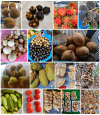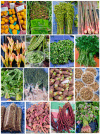Plant-Based Functional Foods from Borneo
- PMID: 39861330
- PMCID: PMC11767754
- DOI: 10.3390/nu17020200
Plant-Based Functional Foods from Borneo
Abstract
Borneo, the third-largest island in the world, is shared between Malaysia (Sabah and Sarawak), Indonesia (Kalimantan) and Brunei. As a biodiversity hotspot, it is home to about 15,000 flowering plants and 3000 tree species, of which many are endemic to the region. Locally derived plant-based foods are gaining popularity due to their lower environmental impact, contribution to food sustainability and health benefits. The local fruits and vegetables of Borneo have been used traditionally by the indigenous community for medicinal purposes. This community knowledge can provide a valuable guide to their potential for use as functional foods. This review explores the contemporary foods from Borneo, including fruit, vegetables, seaweeds and plant-derived food products that are locally consumed. The findings show that the unique tropical food groups have a wide diversity of phytochemical compositions that possess a wide array of biological activities including anti-inflammatory, antioxidant, anti-microbial, anti-proliferative, anti-fungal, wound healing and expectorant properties. The wide range of plant-based foods in Borneo deserves further development for wider applications as functional foods.
Keywords: Borneo; Brunei; Indonesia; Kalimantan; Malaysia; Sabah; Sarawak; functional foods; healthy diet; plant-based foods.
Conflict of interest statement
The authors declare no conflicts of interest.
Figures





Similar articles
-
Valuable components of bambangan fruit (Mangifera pajang) and its co-products: A review.Food Res Int. 2019 Jan;115:105-115. doi: 10.1016/j.foodres.2018.08.017. Epub 2018 Aug 6. Food Res Int. 2019. PMID: 30599921 Review.
-
Emerging challenges for sustainable development and forest conservation in Sarawak, Borneo.PLoS One. 2020 Mar 3;15(3):e0229614. doi: 10.1371/journal.pone.0229614. eCollection 2020. PLoS One. 2020. PMID: 32126070 Free PMC article.
-
The genus Ranatra Fabricius (Heteroptera: Nepidae) in Borneo, with a redescription of Ranatra spinifrons Montandon and the description of a new species.Zootaxa. 2019 Feb 12;4555(2):236-246. doi: 10.11646/zootaxa.4555.2.4. Zootaxa. 2019. PMID: 30790959
-
Catalogue of oribatid mites (Acari: Oribatida) from the Malay Archipelago.Zootaxa. 2019 Dec 24;4716(1):zootaxa.4716.1.1. doi: 10.11646/zootaxa.4716.1.1. Zootaxa. 2019. PMID: 32230660
-
Vector-borne diseases on Borneo island: a scoping review.Malar J. 2024 Nov 11;23(1):337. doi: 10.1186/s12936-024-05132-5. Malar J. 2024. PMID: 39529029 Free PMC article.
Cited by
-
Fermentation of Fruits and Vegetables: Bridging Traditional Wisdom and Modern Science for Food Preservation and Nutritional Value Improvements.Foods. 2025 Jun 20;14(13):2155. doi: 10.3390/foods14132155. Foods. 2025. PMID: 40646907 Free PMC article. Review.
References
-
- Ray M. Order in the Court: 10 “Trials of the Century”. Encyclopedia Britannica. [(accessed on 10 December 2024)]. Available online: https://www.britannica.com/list/order-in-the-court-10-trials-of-the-century.
-
- Mocatta G. Borneo’s Biological Treasure Trove. 27 March 2012. [(accessed on 10 December 2024)]. Available online: https://www.bbc.com/travel/article/20120323-borneos-biological-treasure-....
-
- McLellan J. Strategies for revitalizing endangered Borneo languages: A comparison between Negara Brunei Darussalam and Sarawak, Malaysia. Southeast Asia. 2014;14:14–22.
-
- Keong C.Y., Onuma A. Transboundary ecological conservation, environmental value, and environmental sustainability: Lessons from the heart of Borneo. Sustainability. 2021;13:9727. doi: 10.3390/su13179727. - DOI
-
- Moate M. What Causes Deforestation in Borneo and How Do We Stop It? Earth.Org, 2 March 2023. [(accessed on 10 December 2024)]. Available online: https://earth.org/deforestation-in-borneo/
Publication types
MeSH terms
Substances
LinkOut - more resources
Full Text Sources
Research Materials

